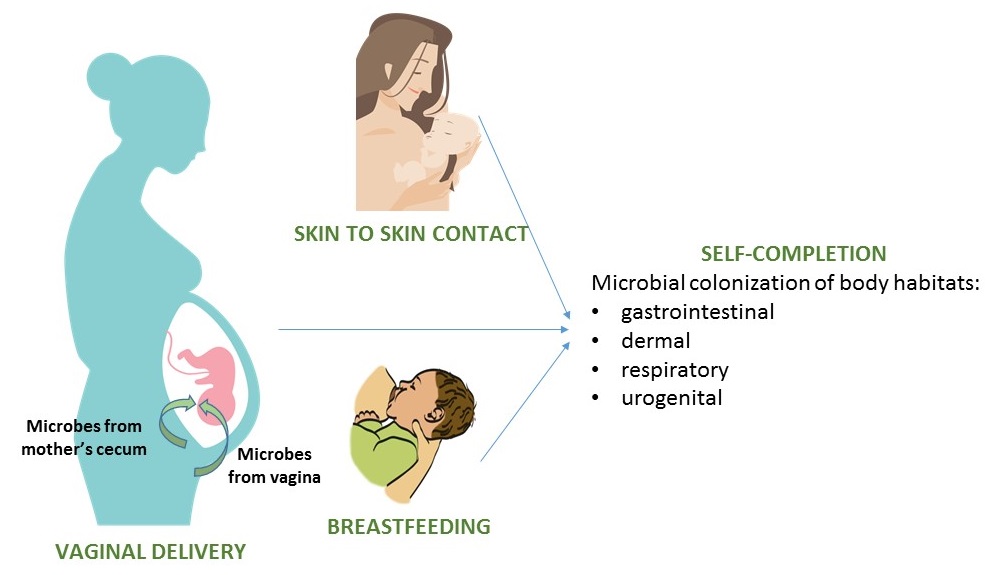While there is exposure to microbes during fetal live, the event that properly seeds the baby’s microbiota is birth. This is when the transfer of microbes that will become the founders of the baby’s microbiota occurs. But nowadays the birth process can be very different from one baby to another and therefore the microbial transfer differs significantly too.
Mode of delivery
Let’s consider mode of delivery first. In fact, this event is key for the primary establishment of the newborn’s microbiota.
Ideally, a baby would come to the world via vaginal delivery. When this happens, the baby descends through the birth canal and, during this short but amazing journey, becomes exposed to the mother’s microflora from the vagina and large intestine (especifically, to a small portion of it called cecum). This is how these mother’s microbes establish themselves in her newborn’s gut. And this transfer repeats generation after generation (if births are all vaginal), thus inheriting our mother’s microbiome across generations like we intherit maternal mithocondria. Not a trivial issue, as our microbial genes comprise the majority of our total genome.
How about cesarean delivery? Babies born this way lack the mother’s microbes found in her vagina and cecum, as they do not pass the birth canal. Here, there is a disruption of the intergenerational transfer of the microbiome I mentioned earlier. What type of microbes are found in these newborns and how do they acquire them? Well, the how has yet to be defined but their microbes are those typically found in the human skin rather than in the vagina, as is the case with babies born by vaginal delivery.
C-section is associated with higher rates of many diseases like allergies, asthma, diabetes, obesity or autoinmune disease. Evidence points at this different microbial seeding of the newborn as the foundation for the development of many diseases. For instance, the vaginal microbiota in a healthy woman is rich in lactobacillus. This is a genus of bacteria with many species important for health. Also, C-sections have been associated with lower microbial diversity and altered maturation of the immune system in the first 2 years of life. Both microbial diversity and propper inmune maturation are important for lifelong health and, as we will see, the immune system co-matures alongside the microbiome.
Other seeding events
The transfer of microbes from mum to baby doesn’t end with birth. Skin-to-skin contact straight after delivery is also key for seeding the baby’s microbiota. At this point, though, the newborn can come in contact with other people, appart from mum, and thus with their microbes. Skin to skin may also happen with dad and even siblings, and their microbes are also welcome. Another opportunity for transferring microbes, this time from the mouth, may be kissing. All these events combined will determine the baby’s microbiota and microbiome. But another critical event for molding her microbiota that occurs around birth and beyond is breasfeeding. Again, an exclusive transfer from mum to baby.
Breastfeeding
Research in breastfeeding keeps giving us incredible insights on how delicate, complex and well engrained it is with both mum’s and baby’s physiology. When breastfeeding is well established, mum and baby are like one body, with physiological processes atuned and interconnected that cannot be understood separately. The connection between mother and newborn establishes at many levels. Let’s focus on one of them now: the microbiota.
As I said earlier, a baby born by vaginal delivery is seeded with mum’s microbes from her vagina and a small part of her colon. Science has shown that the same strains of bacteria coming from the mother get established in the baby’s gut and co-mature with her mucosal immune system. Now, here is where breastfeeding comes into play to carry on the work. Breast milk contains specific components derived from the mother’s immune system, which will help with the maturation of the baby’s own inmunity. Moreover, breast milk also carries more microbes and the nutrients tailored for the specific gut microbiota that has been passed on. On top of that, brest milk can help the microbiome to keep on maturing.
